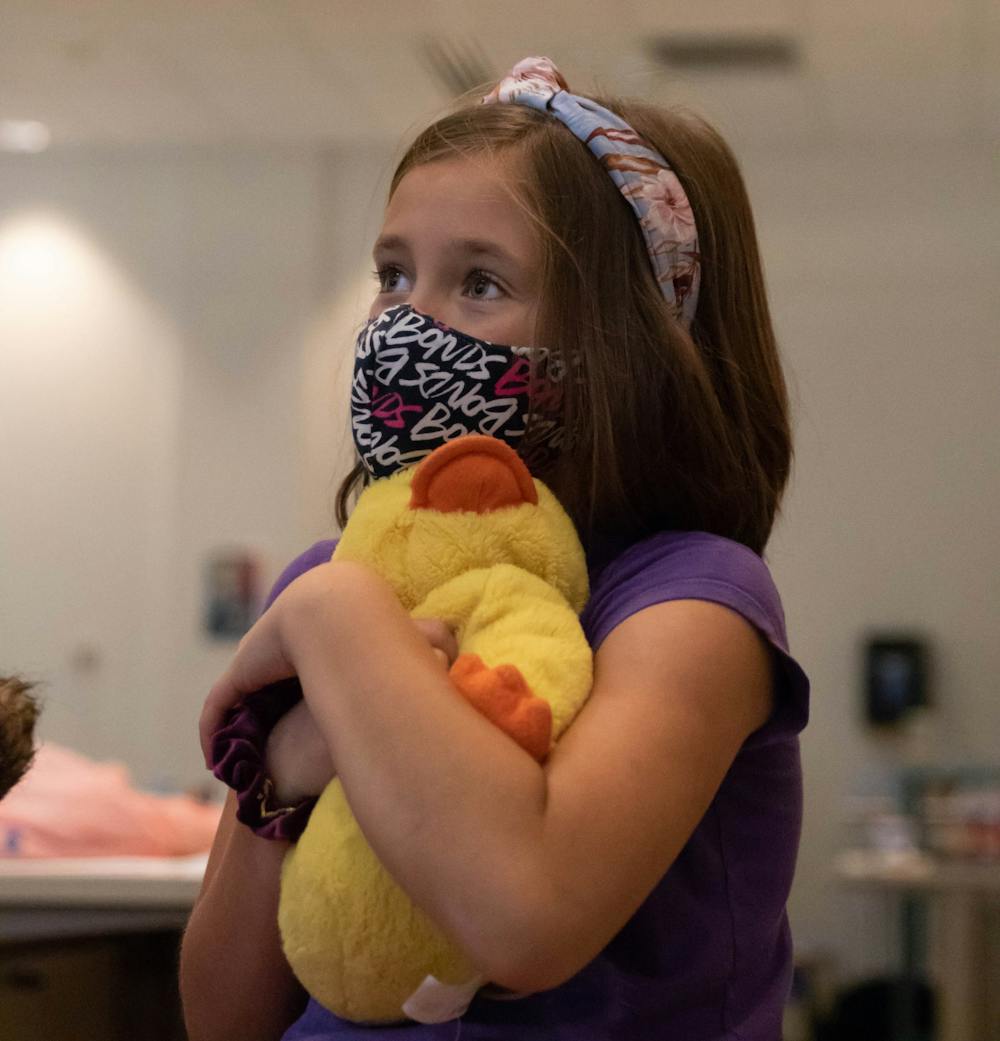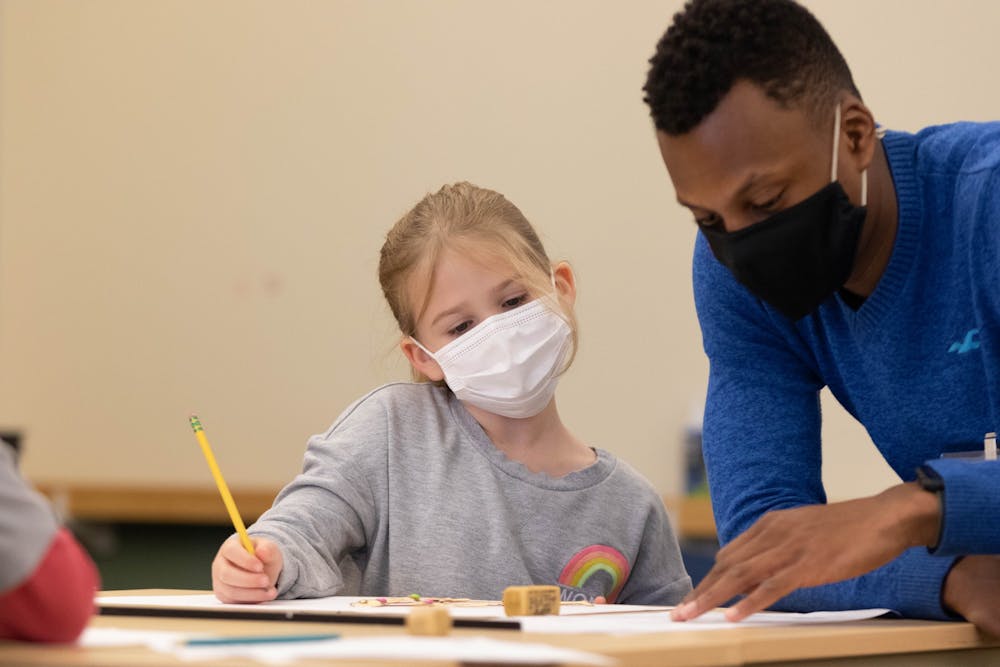The last day for the Saturday Children’s Art Classes is Nov. 20. The class will put on a final celebration of the students’ work with an overview of the projects the students have studied and will end with an exhibition of their artwork. Masks will be required.
The classroom is filled with high-pitched clamor.
As children chat about everything from their favorite color to Minecraft, the teacher steps in front of the whiteboard, raises his arms and gives a loud “clap, clap, clap clap clap.”
The kids suddenly fall silent and respond — “clap, clap, clap clap clap.”
Class is now in session.
This year’s annual Saturday Children’s Art Classes (SCAC), an elementary practicum for art education majors at Ball State, are back in-person in the Art and Journalism Building after being conducted virtually via Zoom for the 2020-2021 academic year. The SCAC is coordinated by Mary Carter, assistant professor of art education.
When Carter was an art education student at Ball State in 1978, she taught the classes to kids as well.
“About eight years ago, a grandmother attended the classes with her granddaughter — she sat in the room with her,” Carter said. “I learned she had been a student in the Saturday Art Classes as a child, and she was now in her early 70s.”
In other years, her role in the School of Art program has consisted of preparing her elementary art education students to execute an eight-week lesson plan and make classes to teach registered elementary school students.
Carter said the goal of the SCAC is to teach four specific disciplines of art — art criticism, aesthetics, history and production — at a level simple enough to introduce to elementary-aged students in Muncie. Last year, however, was no ordinary year for the program. In July 2020, Carter found out classes would have to be conducted online due to COVID-19 concerns.
“I thought, ‘What are we going to do?’ Because this is their elementary practicum, they have to do it in order to graduate,” Carter said.
Carter’s problem was three-fold. She needed a way to record her student teachers’ online classes, find a place for them to share their lesson plans with their students and find a way to remotely accept payment for the program — all within a month before the fall 2020 semester began and registration for the SCAC would open.
The first problem had a simple solution, Carter said, as Zoom meetings can be recorded by the host and saved to their computer, but the second problem wasn’t as easy to solve.
Carter cycled through several websites and programs, such as Canvas, Planboard and Weebly, but each site required too much setup and training to employ on such short notice. Then, she said she came across Google Sites.
“It’s very, very simple,” Carter said. “I said [to the students], ‘Just get a site, put your name, your times available and one picture — that's all you need, just to make friends with it.’”

Between training from Jacquelin Analco, 2011 Ball State alumna and Jay County High School art teacher, and studying YouTube tutorials for Google Sites, Carter and her student teachers became acquainted with the program and could post assignments online for each of their classes.
Ben Johnson, Ball State director of student financial systems, told Carter he would help her with her last problem, and he set up a credit card enrollment system for the SCAC. Now, the organization can accept payment not only through mail, but online as well.
“By the time fall started, we had teacher websites, public school students who could enroll by credit card and they also had to have a laptop to use,” Carter said. “We had really everything we needed. The teachers develop their curriculum, just like they normally would do.”
The 2020 Saturday Children’s Art Classes began with the theme, “The Old is New Again!” During this time, Carter said her student teachers had a unique and realistic teaching experience because of the COVID-19 pandemic and having to conduct their art classes online.
“I thought it was fantastic because they learned how to do everything online that every other teacher in the whole country was having to learn,” Carter said. “It was really, really stressful on [the student-teachers] because, at the same time, we had to deal with the fact that not all of [the students] had good Wi-Fi.
“There was another student who was meeting with me from northern Indiana and, if she didn't stand by a certain window in her house, she couldn't get through, ” she said.

A student sits at the Team Chicken Nugget Artist table in the Saturday's Children's Art Class Nov. 13. Each class has, at most, 12 students, so student teachers can easily help their students one-on-one if they need it. Eli Houser, DN
However, this year, the SCAC returned in-person Sept. 25 under the theme, “Expressively Astounding Art!” with added depth on account of last year’s adaptations during the COVID-19 pandemic. If students need to isolate or quarantine for a week or two, they can still join via Zoom and participate in the class.
Art education students at Ball State take two intertwined courses for their major: Art Education: Curriculum and Instruction (AED 304) and Art Education: Elementary Teaching Practicum (AED305). Students research two artists, their works and their techniques in the first course to design a lesson plan to prepare for the latter course.
A student’s lesson plan revolves entirely around the artists they choose — they write lectures, plan activities and make worksheets tying directly into what influences the artists and what makes their techniques effective.
“There's a lot more that goes into teaching a lesson than just, ‘Today, we're going to paint, and we're going to use red, blue and green,’” said Kiley Hurst, senior art education major and one of 10 SCAC student teachers. “It's all based on art history and what you want [the students] to get from it.”
Over time, children in the SCAC develop a portfolio with art made from tempera paint, colored pencils, scissors, paper and glue, reflecting what they have learned from the student teachers and how their art improves with what they learned.
Lauren Walker, one of the program’s parents, heard about the SCAC five years ago from her daughter’s friend’s mother, who had signed her own child up and asked if Walker’s 10-year-old daughter, Violet, would be attending too.
“[Violet]’s gone every year except for last year, when it was virtual,” Walker said. “It’s a social opportunity for her — it’s an opportunity for her to express herself artistically. I’ve been very pleased with it.”
Walker said Violet is always excited to go to the SCAC, and she is sad that next year is the last year she can attend the program because she is in fifth grade and the SCAC only takes students up to sixth grade.
“[Violet]’s like, ‘We’re gonna have to find something similar for me to do,’ after she ages out of it,” Walker said.

Hazel Lewis listens to presentation by Mariel Claxon, art education major, during Saturday Children's Art Classes in the Art and Journalism Builiding Nov. 13. Claxon taught her class of 1st and 2nd graders about Shepard Fairey, a famous American Artist. Eli Houser, DN
The students are not the only ones learning from the SCAC, though. The student teachers are also gaining classroom experience that is true to teaching in the real world.
In the classroom, student teachers direct conversations about art and study and explain important vocabulary words and concepts. In these two-hour long classes, student teachers work one-on-one with students who need or want help with their activities, all while watching the clock and keeping their lesson plan moving at the right pace.
According to the SCAC discipline protocol, student teachers do not use punitive discipline techniques with disruptive students, such as taking away their materials or putting them in timeout, but rather focus on teaching disruptive students how their actions are not invisible and can negatively affect others.
Diana May, 2006 Ball State art education graduate, learned about the program’s classes when she had to observe them for her own art education degree.
“I remember being excited and amazed at the amount of information the students were being given,” May said. “This is the first student teaching experience for most of the student teachers in this program. The amount of research and preparation for this is intense.”
May has two of her four children enrolled in the program right now. Her oldest has outgrown the program, and said all four of her children will have entered or finished the program by the time her youngest child enters elementary school. May drives her kids to Ball State from Noblesville, Indiana, each weekend the classes take place, which is about a 45-minute drive.
“I love when they come out of class and tell me who they have been learning about,” May said. “These art classes expose them to so much more than they are able to get in school. The depth that they study the artists and the techniques is truly amazing.”
Contact Miguel Naranjo with comments at miguel.naranjo@bsu.edu.





